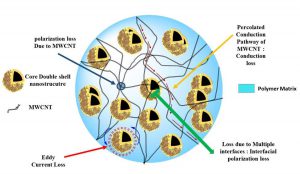Robust nanostructures for EMI shielding
– Gouri Patil

Electro-magnetic interference (EMI) is a persistent issue that plagues modern electronics as it is the main source of noise, disrupting the circuits. The efficiency and robustness of existing EMI shielding materials are quite low, which makes them ill-suited for high-end electronics. To overcome this limitation, researchers led by Suryasarathi Bose in the Department of Materials Engineering, IISc, have designed a novel nanostructure involving a polymer and a blend of nanocomposites.
They have incorporated a conducting carbon nanosphere (CNS) as the core and iron oxide (Fe3O4) and silica (SiO2) as shell materials to develop a core-dual-shell nanostructure. Multiple nanocomposites were integrated in a polymer matrix of polyvinylidene fluoride (PVDF), resulting in EMI shields with highly effective architectures.
The team designed many core-shell configurations and compared their efficiencies. They found that CNS@SiO2@Fe3O4 showed maximum attenuation of incoming electromagnetic radiation ‒ a remarkable 99%. Additionally, these core-dual-shell structures were effective in blocking ultraviolet radiation (both UVA and UVB) up to 99.9%.
The material, apart from being an effective shield, is also durable at high temperature and under mechanical stress, making it suitable for flexible electronics. These structures with multiple interfaces and reduced thickness are desirable for the efficient functioning of devices used for a wide variety of applications, including 5G communication systems and medical equipment.
Reference:
Yudhajit Bhattacharjee, Sambit Bapari, Suryasarathi Bose, Mechanically robust, UV screener core–double-shell nanostructures provide enhanced shielding for EM radiations over wide angle of incidence, Nanoscale, 2020,12, 15775-15790
https://doi.org/10.1039/D0NR02654A
Lab website:
https://sites.google.com/site/polymerprocessinggroup/home




